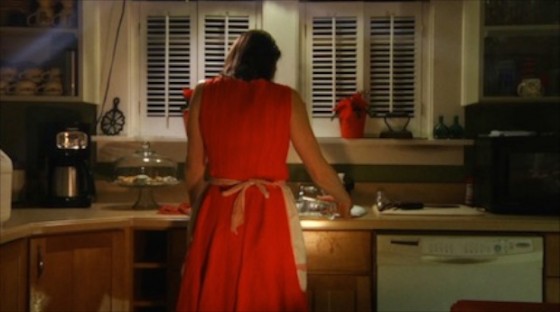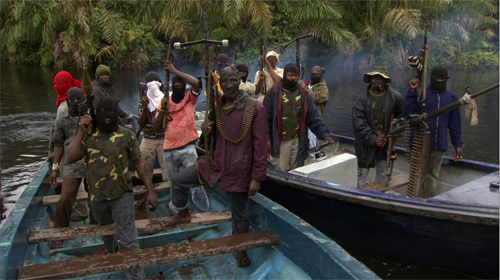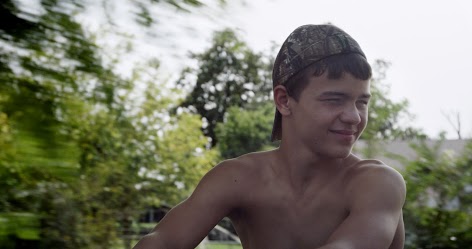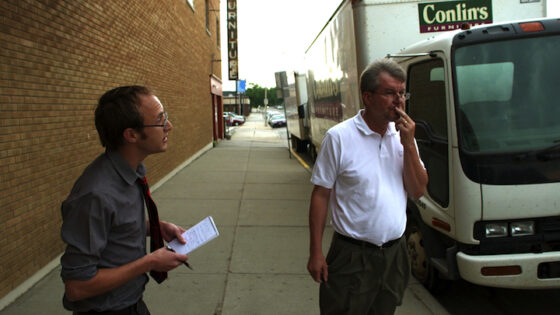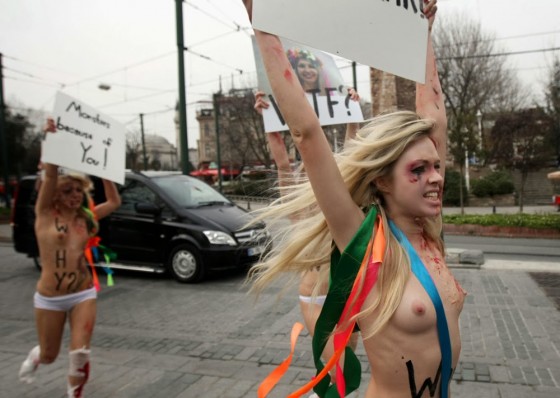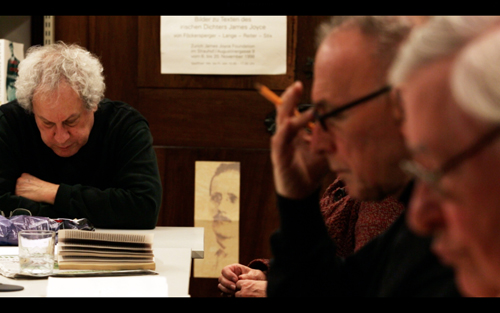Approaching the (Baby) Elephant: True/False 2014
ADAM NAYMAN:
While still far from elephantine, Columbia, Missouri’s annual True/False festival has grown just large enough to accommodate celebrity buzz—or at least jokey rumors that Soulja Boy was going to show up for the closing-night screening of Boyhood. It’s thus also big enough to have finally attracted a little bit of backlash. To cite one small but telling example, the festival’s policy of colour-coded “secret screenings” has been criticized in some corners of the internet because a) it suggests that the programmers are somehow gaming a premiere-obsessed festival selection system, and b) it leads to so many coy tweets about movies the critic is honour-bound to describe at a later date to mollify premiere-conscious distributors. (Said coy tweets are, admittedly, pretty annoying).
Then there’s the question of whether the festival is too self-consciously hip, which seemed to be the idea behind all the fake moustaches I saw being worn by volunteers and attendees (of both genders) at the venerable RagTag cinema. The process by which a young film festival—or really any new cultural product or institution—goes from touted to doubted has become increasingly accelerated, and True/False’s tactic of cherry-picking influential (or at least widely retweeted) film critics to participate in panels and curate sidebars has paid off in the sort of print media and blogosphere coverage often associated with more historically substantial confabs. The list of regional American film festivals (documentary or otherwise) earning appreciative overviews in Sight & Sound and Film Comment (to say nothing of ArtForum) is short indeed.
All of which is to say that, as True/False’s four-day selection of non-fiction cinema has become something of a red-letter dateline—nestled between Sundance and SXSW/Hot Docs as cozily as Columbia rests between St. Louis and Kansas City—it seems like a good time to examine its programming from a few different angles. Amanda Rose Wilder’s very fine verité debut Approaching the Elephant concludes with a quote attesting to the tension (and wisdom) of multiple points-of-view placed in conversation, so with this in mind, Cinema Scope is opting to do True/False polyphonically, as a three-way discussion between myself and Kiva Reardon and Michael Sicinski. (Both of whom were in town for the University of Missouri’s contemporaneous but not officially affiliated Based on a True Story conference, which included roundtables on non-fiction cinema and trauma, documentary’s relationship to journalism, and, to ensure a packed house amidst T/F’s deluge of visiting freelancers, yet another discussion about the digitization of film criticism).
So, to begin: I saw seven films in two days at True/False, three of which I quite liked and all of which were worthy in some way or another. I would have liked to see more movies—and trying to comment on a year’s overall vintage when you’ve skipped town at the halfway point is perhaps unwise—but the ratio of formally challenging works (Exhibit A: Robert Greene’s Actress) to outright crowd-pleasers seems healthy. Even a deeply flawed and extremely popular film like Jesse Moss’ The Overnighters—which I hope both of you have as much to say about here as you did in the hallway after the end of the screening—is something worth discussing rather than dismissing.
My own candidate for a film that is (to borrow the name of T/F’s annual cinema-of-in-between sidebar) “Neither/Nor”—as in neither wholly successful nor in any way a write-off—is Joe Callandar’s Life After Death. The film has two major protagonists: Kwasa, a charmingly callow young Rwandan man trying to go straight after an adolescence spent as a violent street hustler; and Suzette Munson, a Dallas woman who, along with her husband David, has donated more than her fair share of time, money, and attention to his cause. That Suzette, a devoutly Christian woman who co-founded the online retail business Love 41 (whose profits go towards funding ministry activities in Africa) is also one of Life After Death’s producers testifies to the fine line that Callandar is walking here. It’s hard to tell from scene to scene if the film is advocating its financiers’ neo-missionary mentality or subtly prodding it; a scene that introduces the happy couple tooling around Texas to a twangy soundtrack manages to be both satirical and cheerfully celebratory.
The problem with Life After Death, at least for me, is not this neither/nor quality, which, along with Kwasa’s deceptively open-faced charisma (he loves the camera at least as much as it loves him), makes it watchable from beginning to end. What bothered me was that, given its fraught production context and setting, Life After Death feels like an oddly low-stakes proposition, or else a critique so subtly double-edged that it doesn’t draw blood. Shot in the same location as Callander’s previous film (and my favourite short film at last year’s True/False), the hilarious and cutting two-minute short Tina Delivers a Goat—whose title is most decidedly not a metaphor—Life After Death is very much a companion piece to its predecessor, but its examination of Western philanthropy is scarcely better developed despite the considerable bump in the running time.
My least favourite moment in Life After Death involves the brief insertion of some archival footage to make the horrors of Rwanda’s history explicit: it’s a bold move, but also maybe an unnecessary one. Turning things over to you, Michael, I’m curious about whether any of the films that you saw at True/False were similarly marked or marred by chancy and/or miscalculated moments. I’m also interested in your take on Approaching the Elephant, a portrait of a Newark-based “free school” which reminded me in many ways of the work of Allan King—not only the obvious touchstone Warrendale (1965), but also Come On, Children (1973), about a group of teenagers invited to live together communally in the boonies. In the best moments of Approaching the Elephant, I recognized something of King’s patient ability to allow social ecosystems to reveal themselves without showing his own ideological hand. What say you?
MICHAEL SICINSKI:
Miscalculated moments? Not to sound like someone trying to lead a backlash or anything, but there were about as many miscalculations as my 9th-grade algebra test, and I wasn’t much of a math student. As we discussed here and there when we’d meet by chance during the festival, my big gripe about a lot of the films was that their makers seemed entirely too fixated on a conventional idea of storytelling, and the concept of a “narrative arc” in particular. I honestly don’t know if this has to do with the influence of the Sundance and Tribeca Labs, or, as we conjectured, if it has to do with the struggle for funding and the need to generate clear, concise grant language regarding your project—which then, sadly, becomes a streamlining impulse within the filmmaking itself. But it seems to me that the advantage of working with real life ought to be its messiness and unwieldiness, the fact that it leads to loose ends and muddled questions. Instead, a film like E-Team not only depicts Human Rights Watch’s Emergency Team through a selection of five of the most improbably photogenic war-zone activists ever assembled, but begins with hints of a pregnancy and ends with the birth of the E-Team couple’s baby. It’s also a film that pornographically zooms in on a Syrian mother as she weeps about the death of her sons in a bombing raid. (It’s okay, lady! Life goes on. Just watch the film!)
I also found that films like The Overnighters and Rachel Boynton’s Big Men were far more interested in maintaining tensions and keeping situations in play for the viewer than in plunging into the complexity of their respective situations. Kiva, as you pointed out in our discussion, The Overnighters has several opportunities to actually discuss the question of fracking in North Dakota, and how this economic boom is at the expense of the local environment, but this would divert Jesse Moss from “his story.” Likewise, Big Men, which is about a Texas oil speculation firm discovering the first crude deposit off the coast of Ghana, is so fixated on its particular economic drama—the relationship between US entrepreneurship and post-socialist African statism—that it refuses to look at how these issues are connected to other social and political matters. Boynton previously made Our Brand is Crisis and starts Big Men with a Milton Friedman quote, so one presumes that she is not a fan of global capital. Yet she’s so intent on making her film a story about charismatic individuals, and organizing her film as though US oil interests and Ghanian governmental corruption are forces on an equal playing field, that Big Men comes off like a bland neoliberal advertorial: only capitalist investment can save the two-thirds world, so let’s try to make it as fair as we can.
Even relatively strong docs fell prey to these streamlining tendencies and a troublesome adherence to indie-film conventions. Cynthia Hill’s Private Violence is a film I didn’t think very much of until I saw all the other T/F films, and then I realized how solid it really is for an “issue” film. It’s true that its focus on a single domestic violence advocate in North Carolina is a bit narrow, but I think as portraiture it works quite well, and the film’s dialectical structure (one primary case alternating with brief contrapuntal encounters with others) is smart and effective. Even aspects of the cases that are left unarticulated (race, class) are very much present in the film, and don’t need to be announced as such. My only real problem with the film is that, since it doesn’t really explore socioeconomics or geographical diversity, it could inadvertently play into some viewers’ biases about the South.
Similarly, Andrew Droz Palermo and Tracy Droz Tragos’ Rich Hill was a film many of my colleagues praised in advance of my seeing it, and it is a pretty strong debut, even if many of its stylistic moves—the tracking shots of desolate small-town America, the shirtless boys finding exuberant freedom in the midst of deep poverty—recall Harmony Korine, David Gordon Green, and some of those recent Levi’s commercials. Granted, I don’t much trust a film that relies entirely on straight cuts except for one single moment, when an unjustly imprisoned mother cries to the camera, which provokes a slow, slow fade. (Crying moms bring out the worst in documentarians, it seems.) I kept wondering, why does Rich Hill focus on three boys? Why not a girl? It’s not like there’s a clear inquiry into masculinity at work here. But then, diversity would have posed certain challenges that the filmmakers apparently weren’t prepared to take on.
Still, there’s something subversive about screening a film like Rich Hill at T/F, as the film’s dirt-poor Missouri town is just three hours from the festival’s home in Columbia. As we’re sitting in a movie theatre watching people onscreen who don’t have hot water or can’t find jobs, I’m thinking, what would T/F’s beer budget (or the money they spent putting me up in a hotel) do for these guys? Not that I’m suggesting liberal charity. The disparity between the dead-enders in Rich Hill and the well-heeled attendees of True/False just begs an implicit demand for a totally new social structure.
KIVA REARDON:
I’m going to swing at that nice soft pitch Michael just threw regarding the motif of “crying moms.” These weeping maternal figures marked two documentaries that resonated with me at True/False, albeit for very different reasons: Jesse Moss’ The Overnighters and Robert Greene’s Actress. Regarding the former, if any film is guilty of forcing a narrative structure on its subject, it’s this one.
As Adam and Michael have both suggested, The Overnighters is by no means a disaster. If anything, it’s the opposite: so finely crafted as to feel manufactured. In fact, certain scenes testify to directorial manipulation—not in and of itself a verboten act, by any means, but troubling in the way that the film refuses to explicitly acknowledge it. In one moment, the film’s main subject, North Dakotan Lutheran pastor Jeff Reinke, rushes home to break bad news to his wife—our imminently crying mom—with the camera trailing behind him. At a distance, we see her rush out of the garage to meet him. At first, Moss’ choice to linger back suggests both a sense of granting privacy to his subjects and simply rolling with the unfolding reality—that is, until we hear the wife’s clearly mic’ed voice on the soundtrack, which gives the doc a disingenuous, reality-television feel.
Now for the weeping. Leaving aside the specifics, the climax of The Overnighters is an anguished confession from Reinke, which brings his wife to tears. Moss’ decision to film the scene suggests a collaboration between him and Reinke, and one that apparently precluded any dialogue with Mrs. Reinke. While this wasn’t perhaps meant to be intentionally cruel, the effect is precisely that: a “gotcha” moment where the weeping wife seems like mere collateral damage at the end of Reinke’s disastrous personal narrative. It was this male-centric myopia that most struck me about The Overnighters. On one hand, Reinke’s attempt to create an all-male space by hosting homeless male oil field workers in his church has some kind of payoff in the final revelation; on the other hand, by not addressing those women who are also present (wives and girlfriends sometimes join their overnighting partners, but aren’t interviewed), Moss simplifies his own subject. In light of what we learn about Reinke in the film’s final scenes, a critic could argue that this omission is deliberate, but that’s too neat. The inclusion of talking-head confessionals by the male overnighters over the end credits clearly allude to a broader community— one in which women are nowhere to be found.
By contrast, Actress, which has no shortage of tears, mixes melodrama and documentary to create a focused and intensely personal film. The subject, Brandy Burre, is an out-of-work actress, “known” for a minor recurring role on HBO’s The Wire. Living in Beacon, New York (where Greene is her neighbour) with her partner Tim and their two children, she’s lost not practicing her craft. “I’m not acting anymore, so this is my creative outlet,” she flatly states in an opening scene, sitting amidst a mess of children’s toys; it’s clear the reality (and role) of being a mother is threatening to overwhelm her. This sense of engulfment plays out comically when Burre reaches up to take a board game off a shelf, only to have another topple down on her head. “Death!” she dramatically proclaims whilst ducking and covering.
If this all sounds highly performative, that’s the point. Greene wisely opens the film with slow-motion shots of Burre applying makeup, acknowledging the manipulation that’s at play in the film and his aim of teasing out a kind of everyday theatricality. This, combined with the way Actress is anchored around a highly staged and stylized shot of Burre washing dishes at the kitchen sink, means there’s never a sense that Greene is seeking any other “truth” than his subject’s, and even that keeps slipping all over the place.
Onwards to the topless feminists: in Kitty Green’s Ukraine is Not a Brothel, the director perilously embeds herself with the women of Femen, the “radical” organization whose members publicly strip to protest patriarchy and Putin, amongst other evils. Green cleverly coaxes candour from her subjects, who come across as less empowered than their strident displays might suggest. Seen working out, primping and streaming Gossip Girl, the Femen crew seem more like a sorority than a subversive movement. (To give the women credit, they do go protest in Belarus and are routinely arrested and beaten by police). The doc begins to examine the contradictions of their tactics, but ultimately structures itself around a man—the group’s founder and self-proclaimed patriarch of New Feminism, Victor Svyatski—and the women’s attempts to free themselves from him.
Green has an eye for editing and comically starts the film with Boney M’s “Rasputin,” nodding to the pop allure of Femen’s appeal (as well as Svyatski’s Svengali-like manipulation of the group). This is one of the more complex questions surrounding the movement: Should feminism fit so easily into, and be embraced by, mainstream culture? Is the revelation of Svyatski’s influence proof that Femen is working within a patriarchal system instead of tearing it down? Sadly, Ukraine looses its focus midway, choosing the neater narrative of emancipation and empowerment while the real politics and paradoxes of Femen are never clearly articulated or explored.
I can hear my editor’s voice muttering “Alright, alright, alright” (and not in a beaming, McConaugheyan drawl), so allow me to end on a positive note. As we’ve all been critiquing the tendency of docs to lean on a narrativized structure, I’ll highlight two that didn’t: Deborah Stratman’s short Hacked Circuit and Dora Garcia’s The Joycean Society. Programmed together, the pairing created a perfect double bill of films that happy wandered around their subjects: privacy (or lack thereof) in a post-Edward Snowden age, and a Finnegans Wake reading club, respectively. The choice to not impose order on these sprawling subjects made for rewarding viewing, which was also heightened by a man laughing like Cape Fear’s Max Cady all through the screening.
ADAM NAYMAN:
Kiva, I’m glad you mentioned The Joycean Society, which struck me as Room 237 for the literary set—its subjects have plunged themselves so deeply into the choppy waters of Jimmy J.’s prose that they sometimes forget to come up for breath. I think Garcia filmed their meetings beautifully—it takes a certain amount of skill to keep a confab between even the cheeriest Irish senior citizens from becoming visually drab—and at just a shade over 60 minutes, the movie didn’t wear out its welcome. (Not to mention that the idea of a miniaturized documentary about an epic work of literature is witty in its own way.) By contrast, I thought that Hacked Circuit almost sort of went on too long with its single-take homage to the art of sound recording, but I suppose it packs its share of virtuosity into that eight-minute camera move (shades of True Detective, not least in the cameo by Harry Caul).
I don’t want to repeat too much of what you said about Actress, but I’ll echo your point about its mixing of melodrama and documentary, which seemed to me to be both novel and effective without ever moving the needle too far in the direction of “self-reflexivity.” As in his very good wrestling doc Fake It So Real (2012), Greene is able to create what feels like a genuine rapport with a subject who is used to acting for a living, and if he doesn’t go too far in intellectualizing the issues at play—i.e., that every documentary is in some way performative—that’s probably a good thing.
At the same time, I couldn’t help but feel a little bit played (or maybe sucker-punched) by Greene’s money shot, that startling late shock cut to Burre’s face as it’s suddenly been bruised and battered by some offscreen event. I remember my seatmate’s audible intake of breath in that moment, which startled me as much as the image; once I’d regained my composure, I found myself detaching a bit from the story onscreen to try to deconstruct exactly what the moviemaker was doing and why. Still, I’m not going to dock a director points for stimulating thought, especially when so many non-fiction films—including at least a few of the other ones I saw at True/False—either don’t warrant or encourage that sort of contemplation.
I’d like to thank you both for taking the time to think out loud here about your respective True/False experiences: I think that in this case, three heads were definitely better than one.
Adam Nayman
